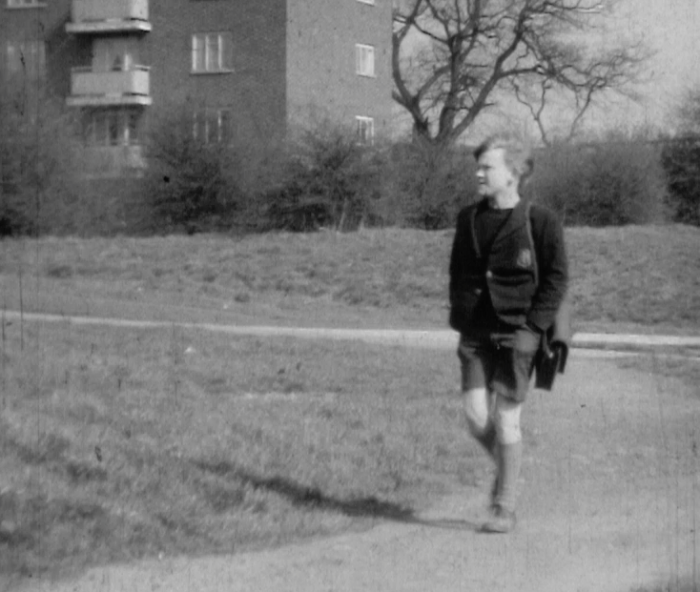
Truant and Fifteen are short, silent, fictional dramas that I made as a teenager when I was experimenting with filmmaking. Truant is a four minute movie in which a young boy (played by my 10 year old brother Richard) decides to miss school for the day. The camera pans from the imprisonment of the school yard to open fields and woods. The boy runs towards the trees, hurling his school satchel down the slope ahead of him. He spends the day by a small river fishing and making an improvised catapult from his sock garter (normal boys’ wear at the time). Early the next morning, he attempts to forge a letter to explain his absence from school, but his mother comes in to the room and finds him …
I made Truant when I was 13 or 14 and it won a minor prize in the Amateur Cine World annual film competition of 1960. Looking back to the time, it’s possible to see parallels with the fourth act of Truffaut’s Les Quatre Cents Coups (1959), where the motif of the abandoned satchel heralds Antoine Doinel’s (Jean-Paul Leard’s) truancy. And the close-up on Richard’s stricken face at the end of the film matches the final shot of Antoine Doinel’s capture. But I don’t think I had seen Truffaut’s film at that time, so perhaps the resemblances are just something to do with the zeitgeist.
In Fifteen, made two years later, Richard is growing up and the world of boyish abandon meets teenage party culture of the early 1960s. He is the leader of a gang of boys who race their bicycles around the suburban streets. They find an abandoned motorcycle in a sloping field and all four ride it down to the bottom of the hill, powered only by gravity and their combined weight. Though it lacks an engine, the motorbike hints at the possibilities of adult life. Finding a party invitation addressed to me (his older brother), Richard goes in my place and tries to pick up a girl, but is rebuffed. Again, the film ends with an image of isolation as he leaves the party alone.
I made two alternative endings to Fifteen. The one I didn’t use is presaged by the scene in the film (after the motorcycle run but before the party) when Richard is given a drum kit for his birthday. He is shown playing the drum with skill, and the later party scene contains shots of a guitar band, The Gravediggers, whose drummer is conspicuously drinking. In this optimistic scenario, Richard’s skill saves the day when the drummer becomes incapacitated. He is welcomed into the band and becomes the toast of the party. Although I shot some of the scenes for this scenario, I felt it lacked plausibility and that a darker ending was closer to experience. In the event, Richard leaves the party alone and the final scene shows him walking up an empty road. The only possible Truffaut reference here is the use of a red filter with black-and-white film stock to give the effect of night during daylight shooting (la nuit americaine).
Fifteen is both thematically and technically a progression from Truant. The title of the film is taken from Beverly Cleary’s teenage novel, Fifteen, which I have never read, but which I believe also deals with problems of teenage identity and relationship. The film is more than twice as long as Truant, and the technique is more assured. The close-ups of straining faces during the bicycle race still convince within the diegesis, although the participants were not actually moving at the time. The original film was accompanied by a tape-recorded soundtrack, mainly music composed and played by The Gravediggers. This was synchronised to the projector by use of a home-made strobe disc which I designed in accordance with instructions in Amateur Cine World. The projector (a 1940s Specto 9.5 mm machine) had a variable speed control (using a rheostat). I mounted the strobe disc on one of the sprocket spindles and used the speed control to keep the strobe markings apparently still, moving neither to the left or the right. As the speed of the reel to reel tape recorder was relatively well governed, this produced acceptable synchronisation of picture and sound (although, of course, lip-sync was not possible).
The audiotapes have been lost, and, in any case, the magnesium oxide coating that holds the audio track would have perished over the last 50 years. But I can still remember the music composed by Andrew Speedy of The Gravediggers, and I shall attempt to recreate it and add sound to the digital version of the films. In the meantime, here are the original silent movies, in digital mode.